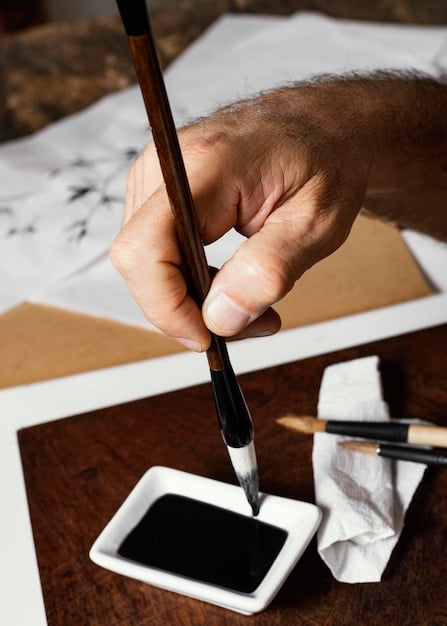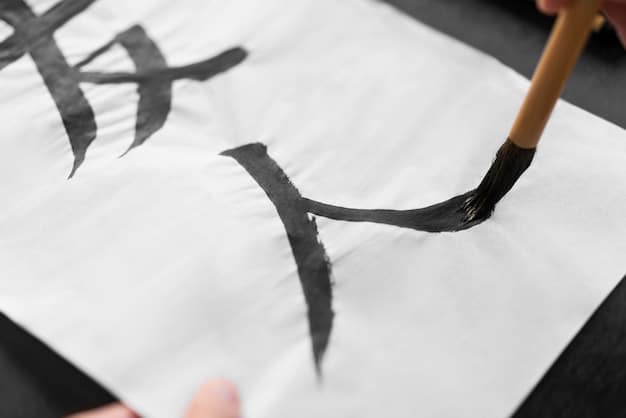Zen Calligraphy: A Beginner’s Guide to Mindful Brushstrokes

The Beginner’s Guide to Zen Calligraphy: Expressing Yourself Through Mindful Brushstrokes explores the meditative art form, offering insights into the tools, techniques, and spiritual principles needed to create beautiful and meaningful calligraphy while fostering mindfulness and inner peace.
Embark on a journey of self-discovery and artistic expression with The Beginner’s Guide to Zen Calligraphy: Expressing Yourself Through Mindful Brushstrokes. This ancient art form offers more than just beautiful writing; it’s a pathway to mindfulness, presence, and inner peace.
Understanding Zen Calligraphy
Zen calligraphy, also known as *shodo* 書道 in Japanese, goes beyond mere penmanship. It is a meditative art form that aims to express the artist’s inner state and understanding of Zen principles through brushstrokes. It’s about being present, letting go of ego, and allowing the ink to flow naturally.
At its core, Zen calligraphy seeks to capture the essence of *sunyata* (emptiness) and *wabi-sabi* (the beauty of imperfection). Each stroke is a reflection of the artist’s mind in that particular moment, unburdened by excessive thought or deliberate control.
The Essence of Shodo
The practice of shodo is deeply rooted in Zen Buddhism. It is not primarily about creating a visually perfect piece of art, but rather about the process itself and the spiritual growth it fosters.
- **Mindfulness:** Shodo encourages practitioners to be fully present with each stroke, fostering a deep sense of awareness.
- **Letting Go:** It helps release the need for control and perfection, allowing for a more natural and intuitive expression.
- **Connection:** It creates a connection between the artist, the materials, and the present moment, leading to a state of flow.
Ultimately, Zen calligraphy is a pathway to self-discovery and a tangible expression of one’s inner world. It is a practice that can bring peace, clarity, and a deeper understanding of oneself.

Essential Tools for Zen Calligraphy
To begin your Zen calligraphy journey, you’ll need to gather the essential tools. These tools, often referred to as the “Four Treasures of the Study,” are carefully chosen for their quality and their role in the meditative process.
Understanding the purpose and proper care of each tool is crucial for a fulfilling and authentic practice. With these tools, you’ll be ready to create beautiful and meaningful calligraphy.
The Four Treasures
The traditional tools of Zen calligraphy are often considered not just instruments, but partners in the creative process. Respect for these tools is key to the practice.
- **Brush (Fude):** Available in various sizes and types, the brush is your primary tool for expressing your inner state.
- **Ink (Sumi):** Traditionally made from soot and glue, sumi ink is ground with water to create the desired consistency.
- **Paper (Washi):** Thin and absorbent, washi paper is ideal for capturing the nuances of each brushstroke.
- **Inkstone (Suzuri):** A stone used to grind the sumi ink stick with water to create liquid ink.
Selecting high-quality tools can enhance the experience and allow you to fully engage with the art form. Each tool plays a significant role in the overall process of Zen calligraphy.
Mastering Basic Brushstrokes
Before diving into complex characters or phrases, mastering basic brushstrokes is essential. These foundational strokes form the building blocks of all Zen calligraphy, and developing a solid understanding of them will greatly improve your overall technique.
Practice these strokes regularly, focusing on control, consistency, and the flow of your energy. The more comfortable you become with these fundamentals, the more freely you’ll be able to express yourself.
Key Brushstroke Techniques
Each brushstroke carries its own significance and requires a specific technique to execute properly. Patience and practice are key to mastering these foundations.
The mastery of these techniques will not only improve your calligraphy but also deepen your understanding of Zen principles. Each stroke becomes a meditation in itself.
- **Vertical Stroke (直筆):** A straight downward stroke, representing strength and stability.
- **Horizontal Stroke (横筆):** A stroke moving from left to right, symbolizing balance and harmony.
- **Dot (点):** A small, concise mark representing a single point of energy or focus.
- **Hook (鉤):** A curved stroke used to emphasize direction or movement, adding a dynamic element to the character.
By focusing on these core strokes, you’ll build a strong foundation for your Zen calligraphy practice and unlock new levels of creative expression.

Understanding Composition and Balance
In Zen calligraphy, composition is just as important as individual brushstrokes. The arrangement of characters, the spaces between them, and the overall balance of the piece all contribute to its meaning and impact.
A well-composed piece of calligraphy will have a sense of harmony and visual appeal, drawing the viewer in and inviting them to contemplate its message. It reflects the artist’s intention and their understanding of Zen principles.
Achieving Harmony in Your Work
Balance and harmony are crucial to creating a visually pleasing and spiritually resonant piece of Zen calligraphy. Consider these factors when composing your work.
- **Space (Ma):** The empty space around and within characters, which is just as important as the strokes themselves.
- **Symmetry:** Striving for balance, but not perfect symmetry, as imperfection is valued in Zen.
- **Flow:** Creating a natural and harmonious flow from one character to the next, guiding the viewer’s eye.
Experiment with different compositions to find what resonates with you. Allow your intuition to guide you, and don’t be afraid to break traditional rules.
Cultivating Mindfulness in Your Practice
Zen calligraphy is not just about technique; it’s about cultivating mindfulness and presence in every aspect of the practice. By focusing on the present moment and letting go of distractions, you can deepen your connection to the art form and gain valuable insights into yourself.
Mindfulness helps you to approach each stroke with intention and awareness, allowing you to fully express your inner state. It transforms calligraphy from a mere activity into a powerful meditative practice.
Techniques for Mindful Calligraphy
Incorporate these techniques into your Zen calligraphy practice to cultivate mindfulness and enhance your overall experience.
By integrating these practices, you’ll find that Zen calligraphy becomes a powerful tool for self-discovery and inner peace. It will help you to be more present, focused, and aware in all aspects of your life.
- **Breathing Exercises:** Begin each session with a few minutes of deep, mindful breathing to center yourself and calm your mind.
- **Sensory Awareness:** Pay attention to the sensations of the brush in your hand, the ink on the paper, and the sounds around you.
- **Non-Judgment:** Observe your thoughts and feelings without judgment, allowing them to pass without getting carried away.
Remember, the journey of Zen calligraphy is just as important as the destination. Embrace the process, be patient with yourself, and allow your practice to unfold naturally.
Exploring Different Zen Calligraphy Styles
Throughout history, various styles of Zen calligraphy have emerged, each with its unique characteristics and expressive qualities. Exploring these different styles can broaden your understanding of the art form and inspire you to develop your own personal style.
By studying these styles and experimenting with their techniques, you can gain a deeper appreciation for the richness and diversity of Zen calligraphy.
Common Styles of Zen Calligraphy
These are some of the most prominent styles of Zen calligraphy, each offering a unique perspective on the art form.
Different styles have come about through the extensive history that Zen calligraphy has. Depending on what emotions you want to convey, you can adjust accordingly.
- **Kaisho (楷書):** The most formal and structured style, known for its clarity and precision.
- **Gyosho (行書):** A semi-cursive style that allows for more fluidity and expression.
- **Sosho (草書):** A highly cursive style characterized by its freedom, spontaneity, and abstract appearance.
Each style offers a unique path for the artist to express themselves and connect with the profound insights of Zen Buddhism.
Finding Inspiration and Continued Growth
Like any art form, Zen calligraphy is a journey of continuous learning and growth. To stay inspired and deepen your practice, it’s important to seek out resources, connect with other practitioners, and embrace experimentation.
By staying curious and open to new experiences, you can continue to refine your skills, expand your understanding, and find ever deeper levels of meaning in your Zen calligraphy practice.
Resources for Continued Learning
There are numerous books, workshops, and online communities dedicated to Zen calligraphy. Take advantage of these resources to deepen your knowledge and connect with other enthusiasts.
- **Books:** Explore classic texts on Zen calligraphy techniques and philosophy.
- **Workshops:** Attend workshops led by experienced calligraphers to learn new skills and receive personalized feedback.
- **Online Communities:** Join online forums and social media groups to connect with fellow practitioners, share your work, and ask questions.
With dedication and perseverance, your Zen calligraphy practice can become a lifelong source of inspiration, growth, and inner peace.
| Key Point | Brief Description |
|---|---|
| 🖌️ Essential Tools | Brushes, ink, paper, and inkstone are fundamental for Zen Calligraphy. |
| 🧘 Mindfulness | Zen calligraphy requires full presence, fostering inner peace. |
| 🖋️ Basic Strokes | Mastering vertical, horizontal strokes, dots, and hooks is crucial. |
| ☯️ Harmony | Balance, space, and flow create visually harmonious pieces. |
FAQ
▼
The main goal is to express one’s inner state through mindful brushstrokes, emphasizing presence and letting go of the need for perfection.
▼
The essential tools are brush (fude), ink (sumi), paper (washi), and inkstone (suzuri), known as the “Four Treasures of the Study.”
▼
Mindfulness enhances the practice by focusing on the present moment, fostering awareness, and allowing for intuitive expression in each stroke.
▼
Common styles include Kaisho (formal), Gyosho (semi-cursive), and Sosho (cursive), each offering unique expressive qualities.
▼
Seek resources like books and attend workshops. Also remember to connect with online communities, and embrace continuous experimentation.
Conclusion
Zen calligraphy is more than just an art form; it’s a path to mindfulness, self-discovery, and inner peace. By understanding the principles, mastering the techniques, and cultivating a mindful approach, you can unlock the transformative power of this ancient practice and express yourself through mindful brushstrokes.





